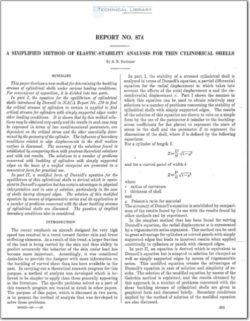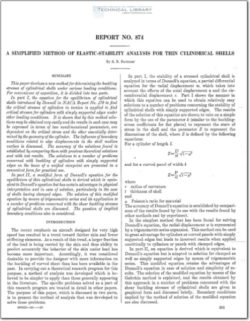NACA-REPORT-874

- Version
- 188 Downloads
- 1.91 MB File Size
- 1 File Count
- March 24, 2016 Create Date
- March 24, 2016 Last Updated
National Advisory Committee for Aeronautics, Technical Notes - A Simplified Method of Elastic-Stability Analysis for Thin Cylindrical Shells

This paper derelops a new methodfor determining the buckling
stresses of cylindrical shells under carious loading conditions.
For coni‘enience of exposition, it is divided into two parts.
In part I, the equation for the equilibrium. of cylindrical
shells introduced by Donnell in NACA Report No. 479 to find
the critical stresses of cylinders in torsion is applied to find
critical stresses for cylinders with simply supported edges under
other loading conditions. It is shown that by this method solu—
tions maybe obtained rery easily and the results in each case may
be expressed in terms of two nondimensional parameters, one
dependent on the critical stress and the other essentially deter-
mined by the geometry ofthe cylinder. The influence of boundary
conditions related to edge displacements in the shell median
surface is discussed. The accuracy of the solutions found is
established by comparing them with precious theoretical solutions
and with test results. The solutions to a number of problems
concerned with buckling of cylinders with simply supported
edges on the basis of a unified viewpoint are presented in a
coneenient form for practical use.
In part II, a modified form of Donnell’s equation for the
equilibrium of thin cylindrical shells is derieed "which is equiv-
alent to Donnell’s equation but has certain advantages in physical
interpretation and in ease of solution, particularly in the case
of shells hating clamped edges. The solution of this modified
equation by means of trigonometric series and its application to
a number of problems concerned with the shear buckling stresses
of cylindrical shells are discussed. The question of implicit
boundary conditions also is considered.
The recent emphasis on aircraft designed for very high
speed has resulted in a trend toward thicker skin and fewer
stifi'cning element-s. As a result of this trend, a larger fraction
of the load is being carried by the skin and thus ability to
predict accurately the behavior of the skin under load has
become more important. Accordingly, it. was considered
desirable to provide the designer with more information on
the buckling of curved sheet than has been available in the
past. In carrying out a theoretical research program for this
purpose, a method of analysis was developed which is be-
lieved to be simpler to apply than those generally appearing
in the literature.
| File | Action |
|---|---|
| naca-report-874 A Simplified Method of Elastic-Stability Analysis for Thin Cylindrical Shells.pdf | Download |
Comment On This Post